By TREVOR HOGG
Images courtesy of Netflix.
By TREVOR HOGG
Images courtesy of Netflix.
It was important that CG creatures like Momo felt like they were making character choices rather than just simply appearing to be cool or cute.
Brought together by Netflix is the visual effects supervisor duo of Jabbar Raisani and Marion Spates who are collaborating on their third series together, beginning with Lost in Space and followed by Stranger Things and Avatar: The Last Airbender. Their current partnership is an epic adaption of the animated series that was previously tried by M. Night Shymalan in a much-maligned feature film that fans and critics would rather burn or bury.
As for what the live-action adaption could achieve that was not possible for the source material, Spates comes up with one word, “Perspective. The cartoon is 2D and hand-drawn perspectives, while this is all done in 3D with proper depth and scale. You are immersed in the show.” Raisani, who also took on the roles of director and executive producer, is in agreement. “Across the board, we tried to represent if this was real, what would this really look like? Hopefully, that allows for a suspension of disbelief that when you’re watching the animated [series], you know that it’s not real, but we tried to make it feel like a real living, breathing world.”
Aang leaves his earthly body and enters the Spirit World.
Aang visits the Fire Nation temple of Avatar predecessor Roku in order to communicate with him.
Spanning eight episodes, the Netflix adaption concludes where the first season of the animated series ended with the Fire Nation laying siege to the home of the Northern Water Tribe as part of its plan to gain global supremacy over the other three nations that have the ability to control water, wind and earth. The main threat is the Avatar, a reincarnated spirit who can master all four elements, who has returned after freak natural accident imprisoned him in a frozen tomb for a century. “We always knew the scale, scope, quantity and quality were going to be difficult because those things never align with the time,” Raisani states. “Specific challenges were Appa and Momo. We knew that we had to nail those characters because how beloved they are, and it took a long time to get them just right. On the Netflix side, working with Ted Biaselli, he was a great resource to look to, talk through the characters and look at the animated series, and he helped us all shape that feeling to get the emotion right for those characters. Once we nailed that, the execution was much faster than we might have anticipated. Bending was hard, too. It was hard to figure out how to do it right. There was a lot of trail and error. It took us awhile to understand exactly what components went into each form of bending.”
“Jared Higgins, who is a Visual Effects Supervisor, came up with the ‘barbershop pole’ as a way to always move the water. We used it to a degree on the other forms as well, but the water is where you see it the most because what we didn’t want was a ball or orb of water. It always feels like it has a current. That you can see throughout the series.”
—Jabbar Raisani, Executive Producer/Director
The Spirit World was shot in the forests of British Columbia and made otherworldly with lens effects such as chromatic aberrations.
A major storyline is watching Katara develop as a waterbender, which had to be reflected in the visual effects work throughout the eight episodes.
Around 3,400 visual effects shots were created for the eight episodes over a period of 18 months by Framestore, Scanline VFX, Important Looking Pirates, Accenture Song VFX, Pixomondo, Image Engine, Rodeo FX, Untold Studios, Outpost VFX, BigHugFX, Cadence Effects, The Resistance VFX, Atomic Pictures, NEXODUS, FABLEfx and DNEG VP. “We looked at the animated series and wanted to mimic everything that we could; however, what do we need to do to ground it in today’s reality?” Spates notes. “We looked at flamethrowers for firebending. For water, we didn’t find a whole lot of reference. We found some water that was in space and a lot of slow-motion buckets of water. You can’t find a water whip online anywhere, but if you do, let us know because we’ll use it for references!” Simulations had to be art directed. “You’re trying to art direct something that is a random event and attempting to use forces to get exactly what you’re after,” Raisani notes. “We understand that you cannot art direct every single drop or drip or element.” A major part of the waterbending recipe was the concept of an underlying force that resembles a twirling barbershop pole. “Jared Higgins, who is a Visual Effects Supervisor, came up with the ‘barbershop pole’ as a way to always move the water,” Raisani explains. “We used it to a degree on the other forms as well, but the water is where you see it the most because what we didn’t want was a ball or orb of water. It always feels like it has a current. That you can see throughout the series.”
Various dangerous beings inhabit the Spirit World, like the angry forest deity known as Hei Bei.
Sokka and Katara witness Aang escaping his century-old frozen tomb.
Getting the glowing arrow and eyes of the Avatar State integrated with the plate photography took a lot of finessing.
Three departments that had to work closely were stunt, visual effects and special effects, all of which had multiple supervisors to manage the workload. “We all start from the moment we are on set,” Spates notes. “We didn’t have an opportunity to come on at the beginning in production, but we were definitely there for the reshoots. The way that Jabbar and I approach things is you get in and work with all of the different departments early on in the process so that way everyone is on the same page of what we’re trying to pull off. They can’t do it without us, and we can’t do it without them.” Easing the communication was an established shorthand. “Fortunately, with people like Jeff Aro, who was one of the stunt coordinators, we worked with him on Lost in Space for years, so there’s an existing relationship that helps to streamline the process,” Raisani remarks. “Nevin Swain was also the prop master on Lost in Space. I know a lot of the crew up in Vancouver from many years of working there.” The special effects team led by Chris Flemington and Mark Gibbard provided some clever solutions. “We had this cool contraption where they could blow wind from a hose,” Spates reveals. “For Aang’s landing, they could just blow the dirt out of the way, so that way we get that effect for free which was great.” Earthbending was mainly digital with exception of some practical debris. “For fire, we had the firelight on their hands to simulate the interactive lighting, and it had to be operated by the board operator, so when someone is bending and doing the firebending all of that has to be timed out and matched exactly,” Spates remarks. “We definitely had some things to figure out for Season 2 because we needed to tighten some areas as far as the interactive lighting and some things that we did on set.”
Along with being a firebender, Princess Azula has the ability to bend lightning, much to the pleasure of her father Firelord Ozai.
A lot of attention was paid to get enough detail between the iris, pupil and sclera for the Avatar State.
“[For the location of the Southern Air Temple] I spent a lot of time in China on another project, but I knew where these amazing mountains [Zhangjiajie National Forest Park] are, which were used in the film Avatar. That’s exactly what we wanted because the scale of those mountains is unbelievable. There is a lot of imagery that we can steal from the Internet, which obviously is what helped us to make such awesome Avatar mountains, because that’s what they have been labeled over the course of the multiple shows that have been there. It was awesome.”
—Marion Spates, Visual Effects Supervisor
Classic scenes were recreated, like when Aang is showing off his airbending skills to a group of children and accidentally crashes into a statue. “It was moments like that where you’re trying to emulate the animated series as well as you can,” Raisana observes. “For that particular shot, Gordon Cormier was on a practical driving rig that drove him around, then we do a swap to a full CG version of Aang. Once he comes to camera, he is digital and full CG, crashes and falls to the ground. We definitely used all of the magic of the practical stuff on set as well as full CG stuff, and pulling from this beloved animated series. Moments like that are fun.”
Something that had to be kept in mind was how and where Katara could summon mass amounts of water that she would be unable to carry.
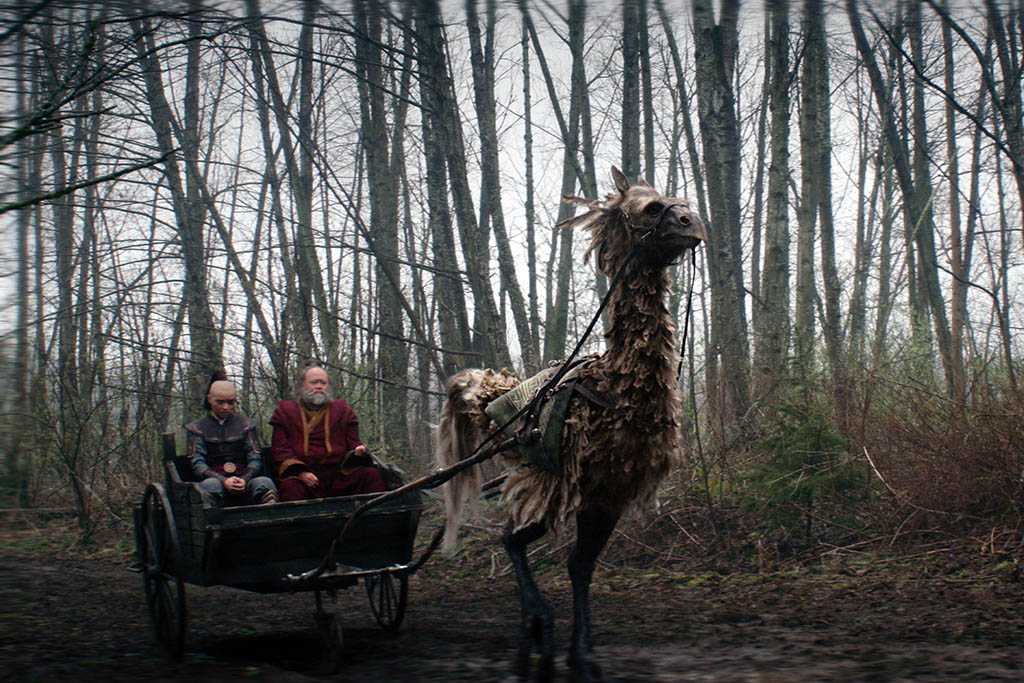
A fun creature to create was the ostrich horse, which is a mode of transportation for the Earth Kingdom.
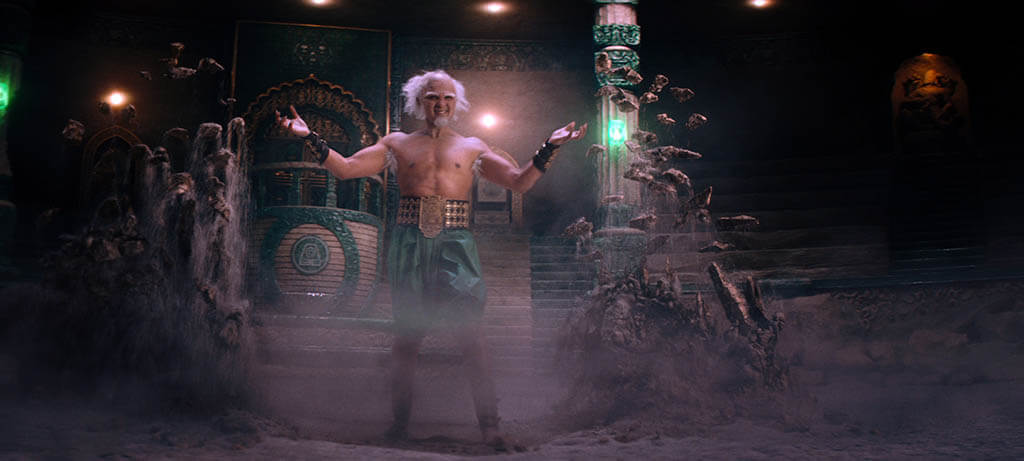
In the majority of cases, the earthbending was entirely digital, such as in the fight between Bumi and Aang.
Interestingly, a cinematic franchise that shares the same name but isn’t related provided the location of the Southern Air Temple. “I spent a lot of time in China on another project, but I knew where these amazing mountains [Zhangjiajie National Forest Park] are, which were used in the film Avatar” Spates recalls. “That’s exactly what we wanted because the scale of those mountains is unbelievable. There is a lot of imagery that we can steal from the Internet, which obviously is what helped us to make such awesome Avatar mountains, because that’s what they have been labeled over the course of the multiple shows that have been there. It was awesome.”
“[W]hat do we need to do to ground it in today’s reality? We looked at flamethrowers for firebending. For water, we didn’t find a whole lot of reference. We found some water that was in space and a lot of slow-motion buckets of water. You can’t find a water whip online anywhere, but if you do, let us know because we’ll use it for references!”
—Marion Spates, Visual Effects Supervisor
Acting alongside the live-action cast were CG characters, with two of the hardest being the air bison Appa and the flying lemur Momo. “There was a huge structure that was covered in fur for Appa that the actors are climbing or riding on top of,” Raisani explains. “There was a lot more of a physical representation of Appa on set and less so with Momo. There is a great scene in Episode 105, which Roseanne Liang directed, where Momo finds a little acorn. This acorn represents the fact that this forest has been burned down is going to be rebuilt. That’s a scene that we worked hard to ensure Momo brought an emotion to his performance and a connection, not only to Katara but to Aang, who is in the position of emotional strife, and make it feel like Momo makes a character choice to give this acorn that he wants to eat to Aang because Aang is struggling and he wants to do something for his friend. It’s moments like that we worked hard to ensure that they are giving a performance as opposed to being cool or cute-looking digital characters.”
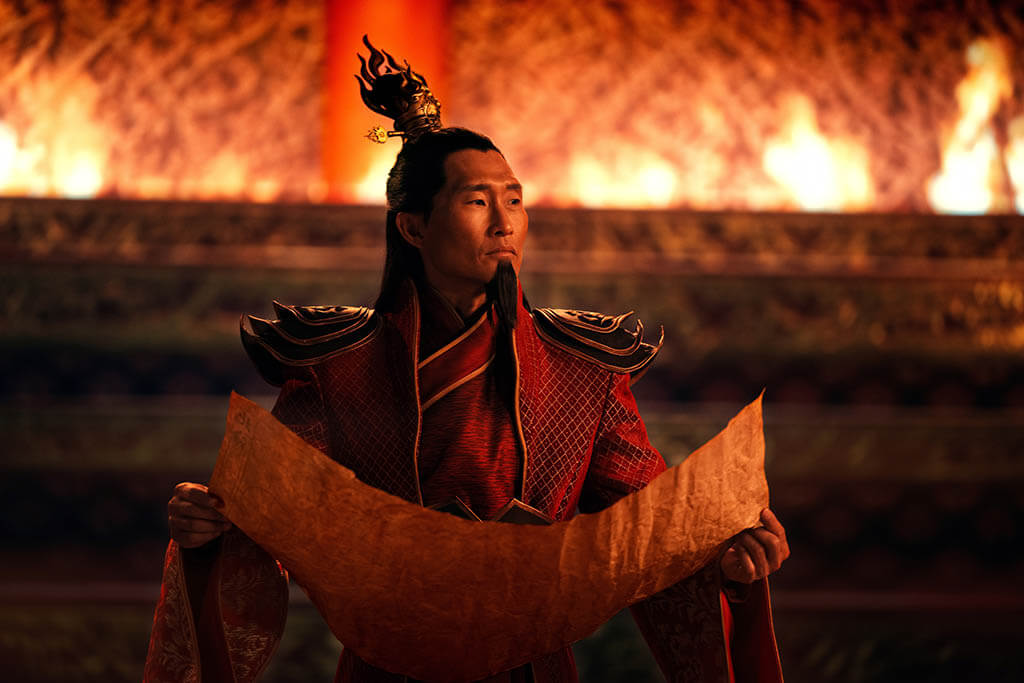
The throne room of the Fire Nation made use of virtual production.
A fun creature was the ostrich horse ridden by the Earth Kingdom. “I love the ostrich horses,” Spates remarks. “Accenture Song VFX worked on that creature and did such a good job of bringing the movement of the ostrich into the ostrich horse. It’s unbelievable how [they captured] just little nuance motions of how they move around and walk. Also, there was the challenge of how do we make it into a horse and how do we make fur bend into the tail of a horse? Also, they had all of the armor, too. That becomes a big challenge because all of that stuff has to be simulated because there’s movement in the armor.”
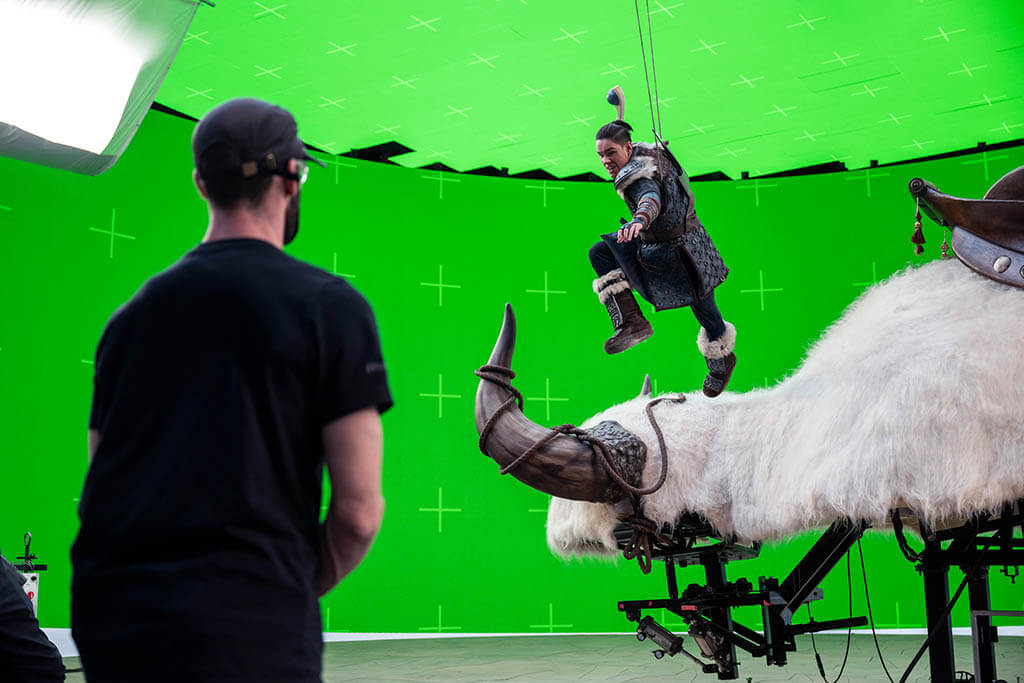
Ian Ousley as Sokka leaps over the fur-covered buck for Appa with the help of wires and greenscreen.
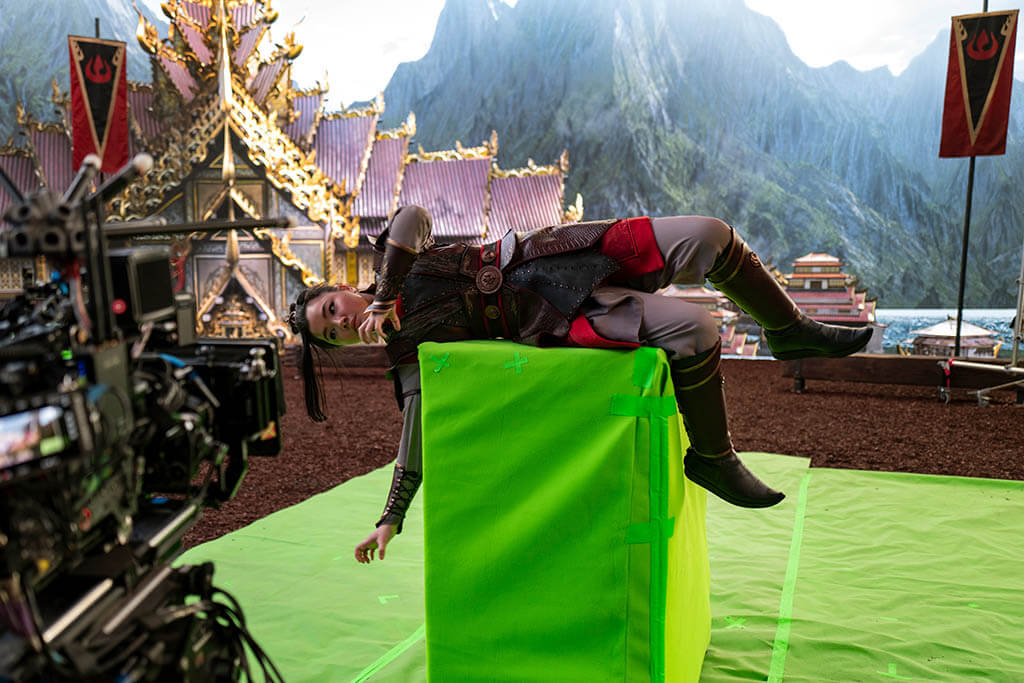
Greenscreen props assisted Elizabeth Yu in achieving the acrobatic firebending that Princess Azula showcases in the series.
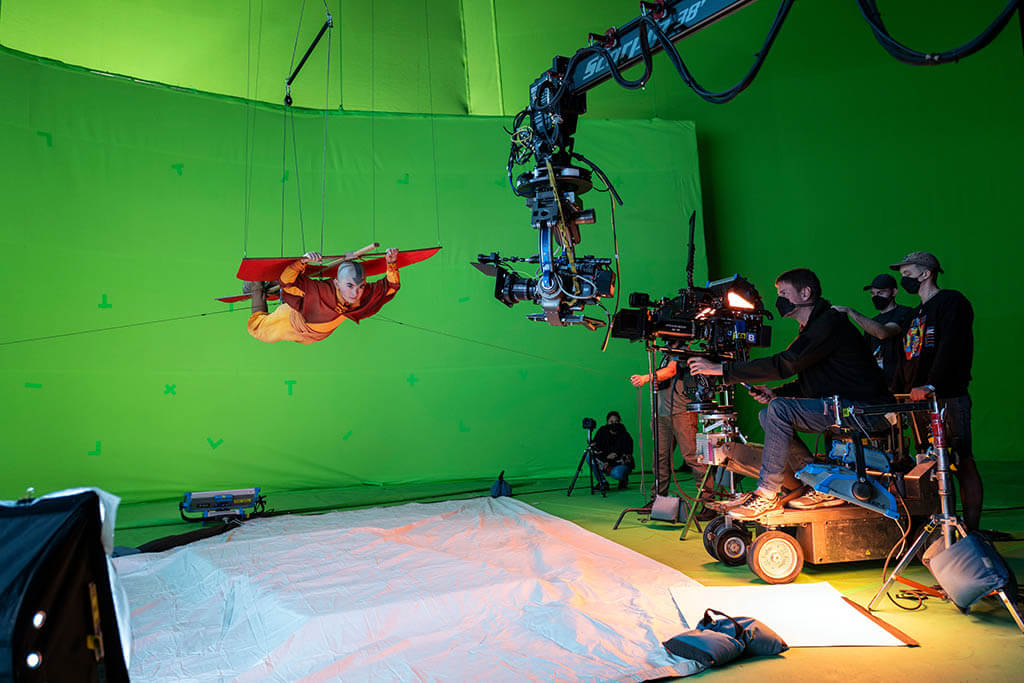
A classic pose is Aang flying using his staff as a glider which involved Gordon Cormier being shot against greenscreen and suspended by wires.
“Another fun sequence is the Aang-Bumi fight, which is part of the block I directed in Episode 104. I leaned heavily on the animated series and tried to do everything I could to represent that animated series in living, breathing form. For every beat that I could, I would grab the animated series and say, ‘We’re going to do this shot and that shot.’ The crew had a fun time shooting it, and we definitely had a great time in post putting that onscreen.”
—Jabbar Raisani, Executive Producer/Director
On a different plane of existence is the Spirit World, which can be accessed via the Avatar State. “I won’t get into how the original footage was shot because we weren’t there,” Spates states. “That was one area we could get creative and stylized. Normally, Jabbar and I stay away from stylized stuff because we always try to keep it grounded.” It was a tricky balancing act achieving the proper visual aesthetic. “We were trying to come up with something that felt heightened but also photographic, so we were leaning on a lot of photographic elements like chromatic aberrations, treating it as if it was something that was happening with the lens but was also happening with Aang,” Raisani remarks. “Especially in that first scene where he hadn’t been in the Spirit World, and we were trying to make it feel almost out of focus. It’s overwhelming, and he doesn’t know how to process it. We were trying to get that visually into the footage, but also emotionally connected with what Aang is feeling. In terms of the color, Marion worked with our in-house vendor to figure out how we take this forest in Vancouver and make it feel heightened, but don’t break to where it does not feel like a real place at all.”
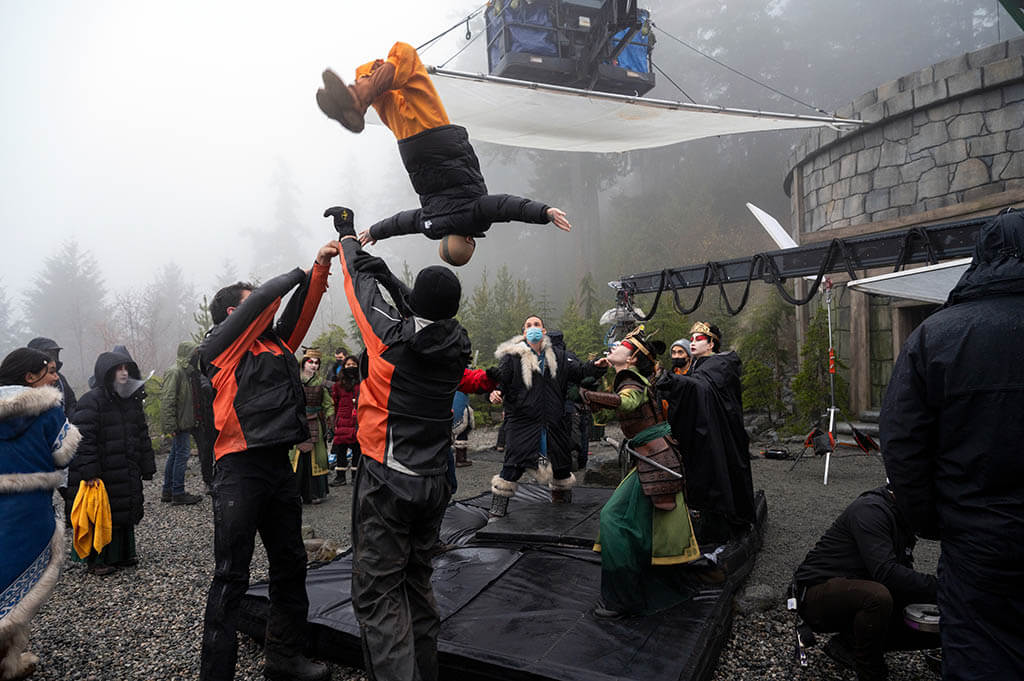
The stunt work was so extensive for the eight episodes that it was divided between Stunt Supervisors Jeff Avro and Dean Choe.
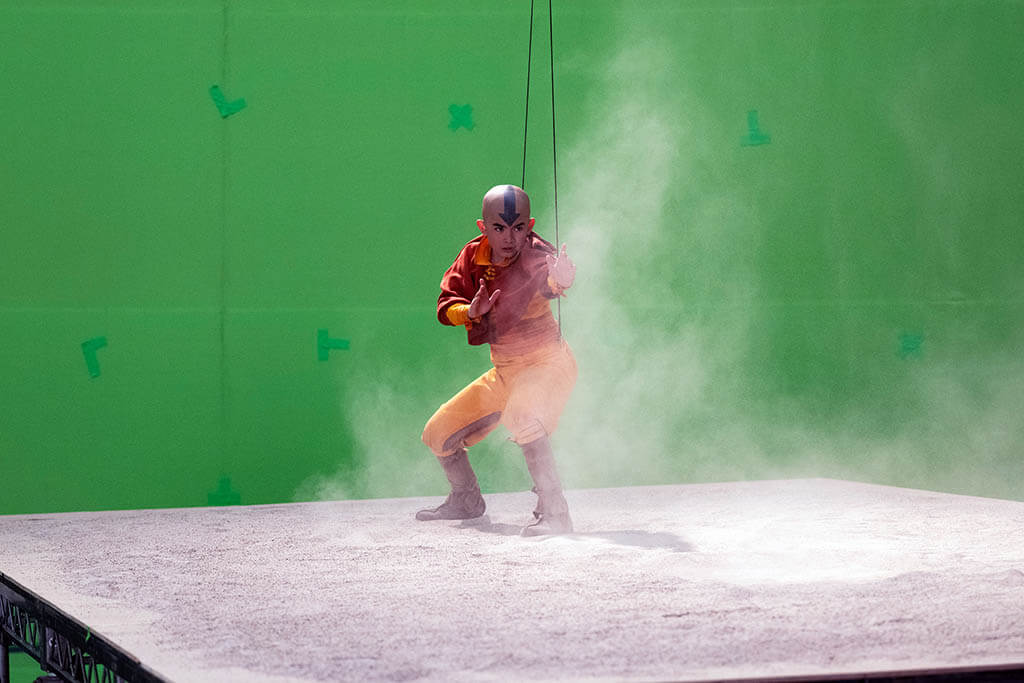
Clever devices, such as wind hoses that stirred up dirt, were critical in making the landings of Aang look believable.
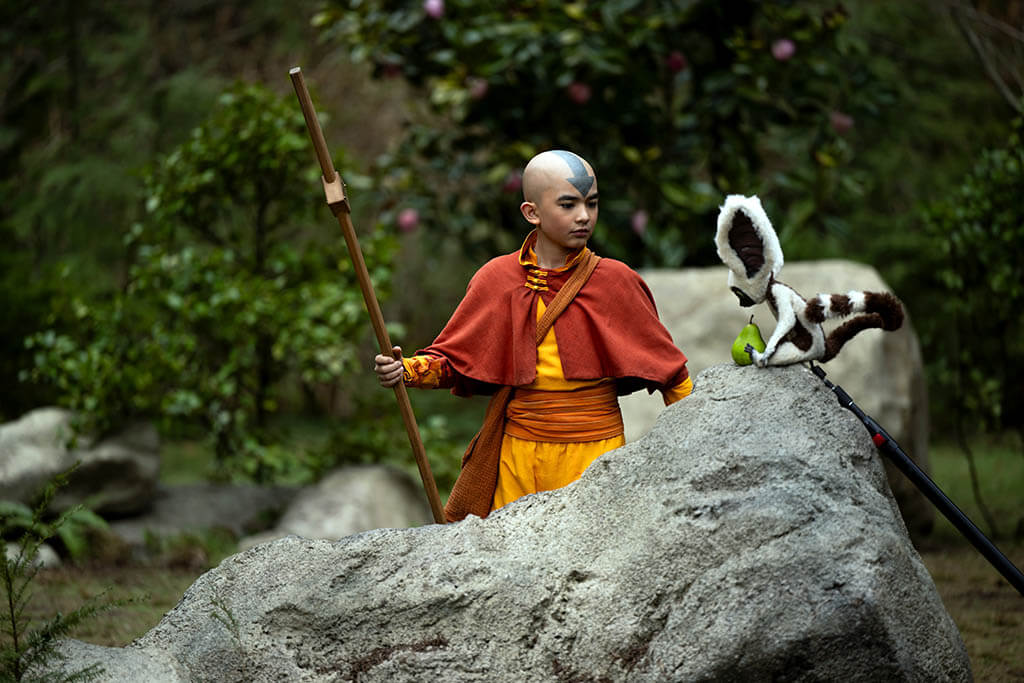
Gordon Cormier performs alongside a stuffie of Momo.
A signature effect is the Avatar State when the Avatar achieves maximum power. “As far as the Avatar State and the arrow and eyes, that was something we put in a lot of effort into,” Spates reveals. “We figured out with one of our in-house vendors what that would look like. The tricky thing is you’re putting all of this illumination and light on an actual image of a character. It’s easier when it’s all in CG, but we couldn’t make the CG aspect of Aang be so far different than the physical production footage of Aang. We had to figure out how to illuminate his head. We have a little of subdermal that we put around the arrow and his eyes. How much detail between the iris, pupil and sclera? We spent days and hours [figuring that out].”
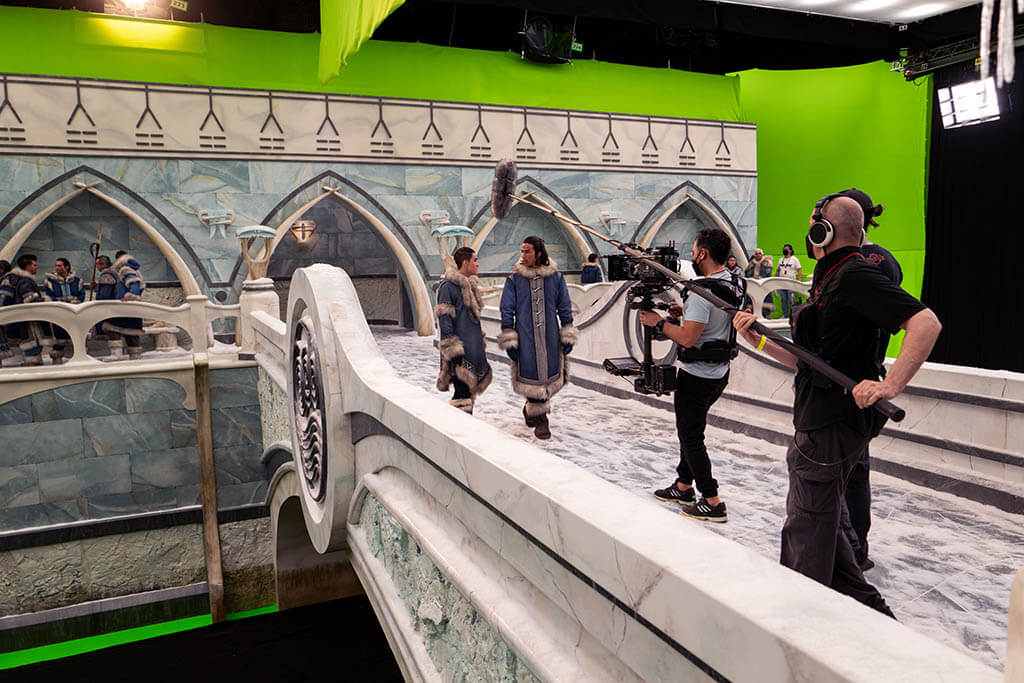
A partial set build of Agna Qel’a, which is the capital city of the Northern Water Tribe.
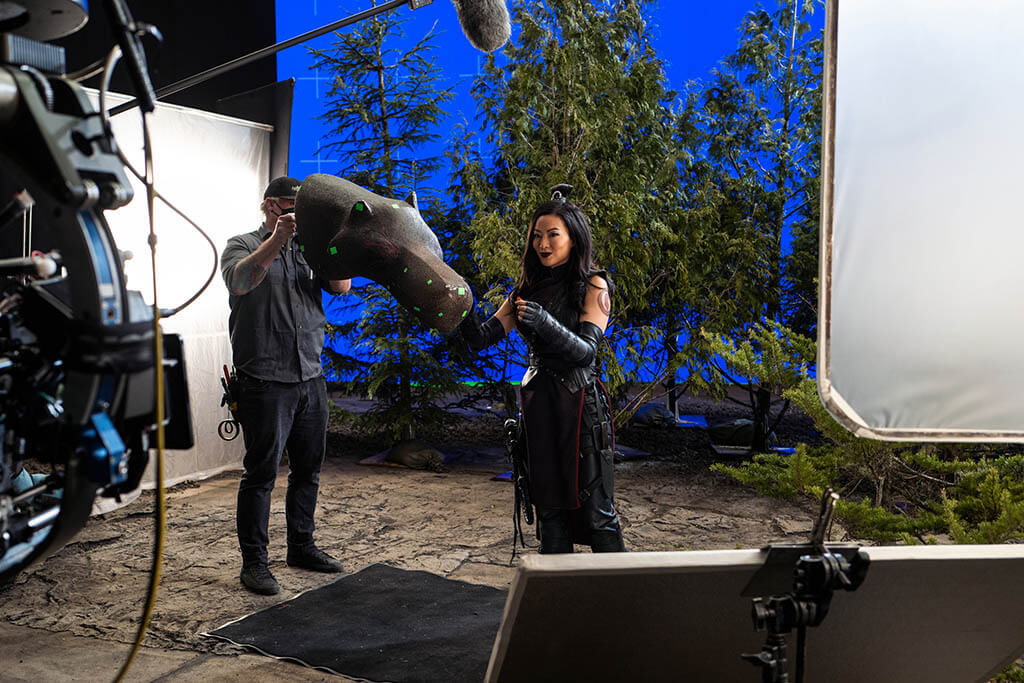
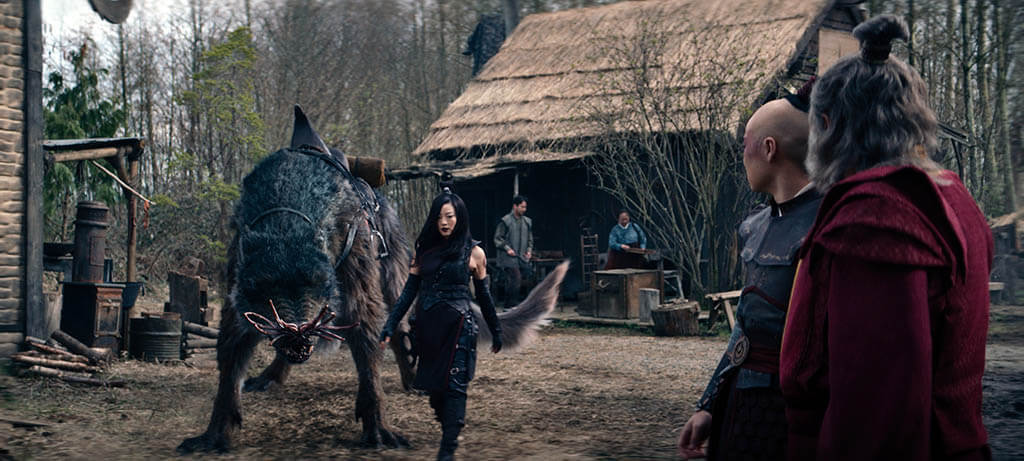
A gray proxie for the head of a shirshu is positioned beside Arden Cho, who portrays the professional bounty hunter June.
Nothing would have been possible without the contributions of the other three Production Visual Effects Supervisors: Jared Higgins, Christopher D. Martin and Alex Gitler. as well as the army of vendors. “Scanline VFX did this incredible sequence of Koizilla wreaking havoc on the Fire Nation, and it’s all done through animation combined with simulations,” Raisana states. “Really complex work that is a combination of character, story, performance and technical complexity. It’s a cool sequence.” Spates agrees with his colleague. “Definitely what I want people to see is Koizilla, which is insane,” Spates says. “You talk about simulation — that is a lot of simulations. It gives me chills to my bones every time I see it. The things that we did to it, also in color, to represent what happens in the animated series has turned out fabulous.”
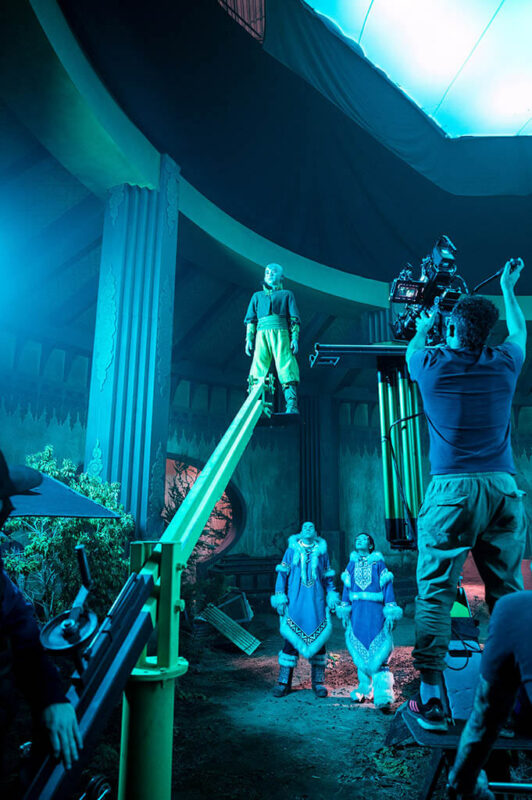
A crane elevates Gordon Cormier as Aang loses control of his Avatar powers upon returning to the Southern Air Temple after witnessing the aftermath of the massacre caused by the Fire Nation.

Getting the cast to interact with the Appa was made easier by the furry gimbal constructed by the special effects team led by Chris Flemington and Mark Gibbard.
Raisani has a personal bias. “Another fun sequence is the Aang-Bumi fight, which is part of the block I directed in Episode 104. I leaned heavily on the animated series and tried to do everything I could to represent that animated series in living, breathing form. For every beat that I could, I would grab the animated series and say, ‘We’re going to do this shot and that shot.’ The crew had a fun time shooting it, and we definitely had a great time in post putting that onscreen.”